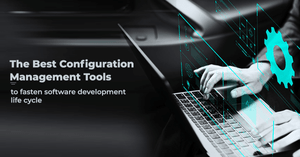What are Software Configuration Management Tools?
Software configuration management tools are deemed very valuable in both software engineering and DevOps. These tools track changes meticulously, ensuring that applications and their infrastructure maintain a known and trusted configuration state. By doing so, they eliminate the dependency on tribal knowledge within development teams, making the entire process more transparent and efficient.
Configuration management software provides an invaluable historical record of system states, aiding project management, audits, and debugging efforts. It enhances visibility into changes within an application and streamlines a company's change control process. These platforms seamlessly integrate with version control systems, software testing tools, bug-tracking software, and other development tools, promoting best practices and productivity.
Why Use Software Configuration Management Tools?
Configuration management in software engineering and configuration management tools in DevOps, offer indispensable advantages for teams and organizations. They simplify the lives of DevOps teams by reducing the risk of human error and minimizing the need for manual effort. Here's why these tools are crucial:
- Preserve and Share Knowledge: In the complex world of application and system configuration, the risk of relying on tribal knowledge is ever-present. Configuration management software changes this by providing a robust record-keeping mechanism. It replaces vague practices with detailed change process documentation, making onboarding smoother and ensuring comprehensive knowledge is readily accessible. This not only streamlines workflows but also promotes better collaboration as configuration documentation can be constantly updated and managed.
- Efficient Configuration: Configuring applications and system infrastructure can be meticulous and challenging to reproduce. Configuration management tools address this by maintaining comprehensive historical records of system states in an easily accessible format. These records also exist as configuration files, enabling the software to automatically configure systems to their desired state.
- Effective System Restoration: System failures, crashes, and bugs are common in DevOps environments. When these incidents occur, the top priority is restoring systems swiftly. Configuration management tools come to the rescue by ensuring configurations are fully recorded and easily reproducible. This simplifies the process of restoring software and systems after crashes, empowering developers and IT professionals to respond rapidly and effectively.
Who Can Use Configuration Management Tools?
Configuration management tools are valuable assets not limited to a single group but are essential for multiple roles within the software development and IT sector. Here's a breakdown of who can leverage these tools;
- Software Developers: Software developers use configuration management tools to oversee and manage application infrastructures. These tools facilitate collaboration among team members during the build process, offering enhanced visibility and the ability to address issues promptly when build configurations encounter problems. Moreover, configuration management software empowers developers to maintain a functional understanding of system states within the DevOps framework, providing more effective collaboration with Operations (Ops) teams.
- IT Professionals: IT professionals, particularly those involved in operations (Ops), utilize configuration management tools to monitor and regulate system states. These tools enable Ops teams to collaborate effectively when addressing infrastructure challenges and enhancing system architecture.
Key Features of Configuration Management Tools
Configuration management tools offer a range of indispensable features that empower efficient software development and system management. Here are the key functionalities that define these tools:
- Configuration Identification: Configuration management tools excel in individually identifying and capturing instances or versions of software products and builds. Each time a build is modified or structured, these tools create a comprehensive historical record, essentially taking a "snapshot" of the entire software state. This feature allows for seamless rollback to previous configurations when needed.
- Configuration Control: These tools formalize internal change processes through robust configuration control. Users can make authorized and documented changes to their software, with team leads having the ability to set permissions to manage access across the team. Configuration control ensures that software changes adhere to best practices and undergo review and authentication.
- Configuration Status Monitoring: Configuration management platforms not only record changes but also actively monitor the status of each instance of an application or system. This continuous monitoring guarantees that the current configuration of every element within the system is always known. With this complete visibility provided by configuration management software, users can respond swiftly and effectively to any issues that arise.
- Automatic Configuration: Configuration management software goes a step further by automating the configuration of applications and systems to their desired state. By capturing and storing software states in configuration files, this software significantly reduces the manual effort involved in configuration. Users can specify desired configurations, allowing the software to automatically reconfigure systems in case of failures.
Benefits of Software Configuration Management Tools
Software Configuration Management tools offer a wide array of advantages that significantly enhance the software development and management process. Here are the key benefits that make these tools indispensable;
- Increase Efficiency: SCM tools streamline and automate various aspects of the software development process, resulting in increased operational efficiency. They enable teams to work more cohesively, reducing manual effort and the potential for errors.
- Define Change Control Processes: These tools provide a structured framework for change control processes. They ensure that every change to software configurations is documented, authorized, and tracked, promoting a systematic approach to managing changes.
- Enable Visibility and Understanding Across Teams and Departments: SCM tools enhance visibility by providing a centralized platform where teams and departments can collaborate and share information. This transparency gives a better understanding of system states and configurations.
- Automate Configuration: One of the standout features of SCM tools in DevOps and software engineering, is their ability to automate configuration. By defining desired configurations and using configuration files, these tools can automatically configure systems to their target states, reducing manual intervention and saving time.
- Allow Quicker Restoration in Cases of Infrastructure Failure: In the event of infrastructure failure or other issues, SCM tools facilitate quicker restoration by providing detailed records of system states. This information helps IT professionals pinpoint and rectify the problem efficiently, minimizing downtime.
Trends Related to Software Configuration Management Tools
In the dynamic world of configuration management in software engineering and SCM tools in DevOps, several noteworthy trends have emerged, reshaping the way organizations manage their software configurations. These trends include;
- DevOps: The fusion of development and IT operations, known as DevOps, has gained prominence as a means to create unified software development pipelines. Configuration management tools play a pivotal role in promoting DevOps workflows by enhancing visibility across teams and facilitating seamless collaboration. They aid in breaking down silos, enabling teams to build, test, and release software more efficiently.
- DevSecOps: With the increasing emphasis on cybersecurity, the DevSecOps philosophy has gained traction. It calls for the integration of cybersecurity best practices into DevOps, placing the responsibility for secure applications on developers. Configuration management tools become integral in bridging the gap between cybersecurity and development by facilitating the necessary changes to software states to ensure enhanced security.
- Continuous Integration and Deployment (CI/CD): CI/CD has become the standard in DevOps best practices. It involves continuous planning, building, testing, and deployment of software, while adhering to project goals and requirements. Configuration management software streamlines development in the CI/CD pipeline, providing agile control over infrastructure for efficient and reliable software delivery.
Top Configuration Management Tools;
Here is a configuration management tools list, highlighting their features and pricing;
| Software | Features | Price |
| Desktop Central | Patch Management, Vulnerability Management, IT Asset Management, Software Deployment, App Management | Price On Request |
| Auvik | Configuration backup & recovery, IT asset management, Network visibility & mapping, Performance monitoring & troubleshooting, Network traffic analysis | Price On Request |
| Server Configuration Monitor | Improve Visibility and Team Accountability, Server Compliance Monitoring, Simple IntegratedExperience, Affordable | $1,156 |
| CFEngine Configuration Tool | Define desired state and IT configuration, Automate updates and changes for all nodes, Utilizes autonomous agents on every node | Price On Request |
| Puppet Configuration Tool | Automate IT infrastructure provisioning, Gain control and visibility in software delivery, Quick changes and issue remediation, Manage infrastructure as code with version control | Price On Request |
| CHEF Configuration Tool | Chef: Push model, cloud adoption, Increase service resiliency, defect-free software, Automation reduces risk, improves compliance, Configure cloud-based SaaS, integrate APIs | Price On Request |
| Ansible Configuration Tool | Easily model complex processes, Receive automation status notifications, Manage entire infrastructure with Ansible Tower, Run tasks on any host or host group | Price On Request |
| SALTSTACK Configuration Tool | Integrates with multiple cloud providers, Simple setup process, DSL feature for logic and states, Introspection feature for insights | Price On Request |
| JUJU Configuration Tool | Software provisioning, Instant integration and scaling, Simplifies service scaling with charm, Supports multiple PaaS on one platform, Kubernetes cluster deployment | Price On Request |
| Rudder | Web Interface for node management and policies, Automates administration tasks, Full REST API for communication, Dynamic host policy generation, Automated hardware and software inventory | Euro 50 per node per year |

















